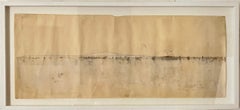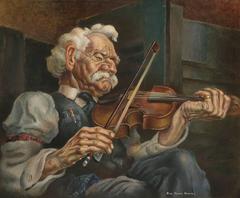A fully finished study/cartoon for the 75th Anniversary mural at the Colorado Springs Fine Arts Center. Framed dimensions measure 33.25 x 38.75 inches
Provenance:
Collection of the Artist
Illustrated:
"Transcending Figuration: Bransby in Retrospect," with essay by Henry Adams, 2014
Expedited and International Shipping is Available; please contact us for a quote.
About the Artist:
Eric Bransby: A Century (Almost) of Mural Painting
by Henry Adams, November, 2014
Eric Bransby, who is now just two years short of a century old, is a living connection to the great age of American and Mexican mural painting. Bransby studied with Thomas Hart Benton, the figure who initiated the American mural movement of the 1930s, as well as with Jean Charlot, who while not usually given credit for this, was the artist who initiated the Mexican mural movement and its distinctive style--though he was quickly pushed aside by Diego Rivera. Not immune to modern influences as well, Bransby also studied at Yale with Joseph Albers, the famous Bauhaus master. Bransby himself has produced some twenty murals over the course of his career, most of them still extant, including projects for Colorado College, Brigham Young University, Rockhurst College, the University of Missouri, Kansas City, The Sedalia Municipal Building, the City Hall in Liberty, Missouri, the Colorado Springs Fine Arts Center, and the Pioneers Museum in Colorado Springs.
I never had the pleasure of knowing Michelangelo, since I was born 500 years too late, but I have a pretty good understanding of the immense challenges he faced when making the frescoes on the Sistine Ceiling from my friendship with Eric Bransby. When I first got to know him, Bransby was working on a fresco of almost Sistine-ceiling size for the library of Park College, located just outside of Kansas City. Kansas City has enormous natural caves which are located in the limestone cliffs that run along the Missouri River. While many of them are extremely large, it's not hard to make them bigger by chipping away at the limestone a little further; and these caves make a perfect place for storing things, since they are water-proof and relatively constant in humidity and temperature: a perfect place for storing books, for example. Indeed, with these factors in mind, Park College placed its library in one of these limestone caves, creating a space that's not simply practical but also something of a visual marvel--something almost out of science fiction--with wonderful skylights that illuminate the rooms from above, and walls that are sometimes finished, like a normal house, and sometimes rough cave walls, like those enjoyed by our prehistoric ancestors.
Bransby's murals for this space used essentially the same fresco techniques that Michelangelo employed, although with some modern twists, since he supported his fresco panels on steel supports just in front of the wall, so that his frescos can be moved to a new location if it's ever necessary to do so, and so that they can stand free from humidity and drips. Needless to say, the fresco harmonized wonderfully with the "architecture" of this unusual library setting, since it's essentially the same limey substance as the walls of the library/cave. And there's something wonderfully ancient or ageless about the effect, as if the figures were cast shadows from some prehistoric campfire. What's fascinating about fresco, of course, is the peculiar demands of the medium itself, which at once demands spontaneity and careful long-term planning. Once you lay the plaster down you need to work quickly, and finish your painting before it dries. But to get to that stage you need to plan things very carefully. Each section of the fresco needs to fit with the next, almost like pieces of a jig-saw puzzle; as in a theatrical production, whether of actors or marionettes, each figure needs to be ready to take make its entrance and take its position in the right place and at the right moment. A year or so of planning and preparation can easily go into a section that's painted in a few weeks. Even the handling of the pigment, in fact, has an element of abstract planning, since the first application of color is often strangely different from the final effect. Human flesh, for example, is first put down in shrieking hot tones of orange, and then magically transformed into natural-looking flesh tones with a subsequent application of pale cool green. What struck me, in fact, is that mural painting is an art with very distinct properties and requirements that separate it from other branches of painting in rather the way that Indo-European languages have separated from each other, with the result that the fact that you can speak Danish does not mean that you can understand French. Similarly, the fact that you can make an outdoor landscape painting does not mean that you can make a mural or a fresco, since that requires different modes of planning and different pictorial skills. Fresco requires a very particular kind of artist with a particular temperament, and Eric Bransby's career has been almost exclusively dedicated to mastering this very particular art form. There's no clear reason why Bransby took this path. His parents, who were of English background, a minister and a homemaker, had no interest in art, and he grew up in Iowa and Nebraska where he had no exposure to museums. His first serious art project occurred in high school: he attended a puppet show and was so fascinated that just afterwards he became involved in constructing marionettes and a puppet theatre with a friend. At some level, this experience with puppetry was a lasting influence. Years later, Jean Charlot described Bransby as a "bone and joint man," and the figures in his murals have always had something of the look of
wooden marionettes...



